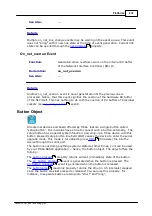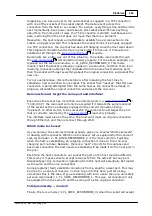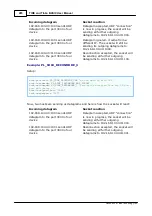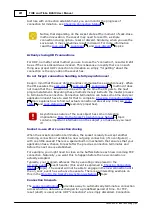
282
Platforms
©2000-2008 Tibbo Technology Inc.
Supposing, you have a host on the network that is engaged in a TCP connection
with one of the sockets of the socket object. The data is sent across this
connection from the host to our socket. For a while, everything is fine and then the
host momentarily loses power and reboots. Our socket doesn't know anything
about this- from its point of view, the TCP connection is still OK. Just because no
data is arriving from the host does not mean that there is a problem!
Meanwhile, the host reboots and attempts to establish a new connection to the
socket- and gets rejected! This is because the socket thinks it is already engaged
in a TCP connection- the one that has been left hanging since the host went down!
This stagnant connection will remain in place until it times out- if timeouts are
enabled at all through the
property.
Reconnects are a nifty way out of this situation. You enable reconnects through
the
(reconnection mode) property. For the above example, you
typically set the sock.reconmode= 2- PL_SOCK_RECONMODE_2. This mode
means, that if the socket is already engaged in a connection, and then there is an
incoming connection attempt that originated from the same host (and any port),
then the socket will forget everything about the original connection and accept the
new one.
For our example case, this is the solution- after rebooting the host tries to
establish a new connection to our socket. The socket then "realizes" that this new
connection is being attempted from the same host as the connection already in
progress, discards the original connection and accepts the new one!
Reconnects must target the same port and interface!
Even when the socket has more than one listening port (i.e.
=
"1000,1001") the reconnect will only be accepted if it targets the same local port
of the socket as the one already engaged in the current connection being
"replaced". In other words, to be successful, the reconnect must target the port
that is currently returned by the
read-only property.
The interface must also be the same. The host can't make an original connection
through Ethernet, and then reconnect through Wi-Fi.
Which mode to choose?
As you can see, the sock.reconmode property gives you several "strictness levels"
of dealing with reconnects. Which one to choose? Let us explain why the choice of
sock.reconmode= 2- PL_SOCK_RECONMODE_2 is the most common. Typically,
when the host is establishing an outgoing connection it does so from the ever
changing port number. Basically, there is a "pool" of ports for this purpose and
each new connection the host needs to establish will be made from the next port in
the pool.
Each time the host connects to our socket the port on the host could be different.
This is why it makes sense to accept reconnects from the same IP but any port.
Disadvantage? Any connection originating from this host will essentially be treated
as the same and the only connection!
Some programs (few!) establish connections from a specific, preset port. This may
be done for a variety of reasons- no time to go into this here- just let us say,
sometimes this is the case. If you are dealing with such a case then you can safely
set sock.reconmode= 1- PL_SOCK_RECONMODE_1. This way, reconnects will only
be accepted from the same IP and the same port as the original connection.
Total promiscuity -- mode 3!
Finally, there is a mode (3- PL_SOCK_RECONMODE_3) when the socket will accept
330
345
339
338
















































